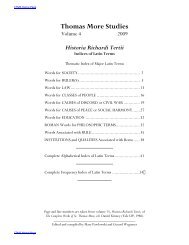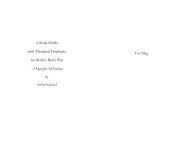life of john picus earl of mirandola - The Center for Thomas More ...
life of john picus earl of mirandola - The Center for Thomas More ...
life of john picus earl of mirandola - The Center for Thomas More ...
You also want an ePaper? Increase the reach of your titles
YUMPU automatically turns print PDFs into web optimized ePapers that Google loves.
5<br />
10<br />
15<br />
20<br />
Twelve Properties <strong>of</strong> a Lover<br />
God will thee help if thou do not refuse:<br />
If other have stand or this thou mayst eftsoon:° 1<br />
Nothing impossible is that hath been done. ¬<br />
THE TWELVE PROPERTIES 2 ⌐ OR CONDITIONS ¬ OF A<br />
LOVER<br />
To love one alone and contemn° all other <strong>for</strong> that one.<br />
To think him unhappy that is not with his love. 3<br />
To adorn himself <strong>for</strong> the pleasure <strong>of</strong> his love.<br />
To suffer all thing, though it were death, to be with his love. 4<br />
To desire also to suffer harm <strong>for</strong> his love, and to think that hurt<br />
sweet. 5<br />
To be with his love ever as he may, if not in deed, yet in thought.<br />
To love all thing that pertaineth unto his love.¦<br />
To covet the praise <strong>of</strong> his love, and not to suffer any dispraise.°<br />
To believe <strong>of</strong> his love all things excellent, and to desire that all<br />
folk should think the same.<br />
To weep <strong>of</strong>ten with his love: in presence <strong>for</strong> joy, in absence <strong>for</strong><br />
sorrow. 6<br />
To languish ever, and ever to burn in the desire <strong>of</strong> his love.<br />
To serve his love, nothing thinking <strong>of</strong> any reward or pr<strong>of</strong>it.<br />
2 eftsoon soon afterwards / 8 contemn despise / 16 dispraise reproach<br />
¦15 <strong>More</strong> omits amicos omnes, domus, uestes, imagines, “all his friends, houses, clothes, pictures”<br />
(CW 1:376, 377).<br />
1. If other . . . eftsoon: That is, if others (i.e., the saints and martyrs) have stood against temptation,<br />
then you are able to do so as well.<br />
2. TWELVE PROPERTIES: After translating the title and list <strong>of</strong> properties from the Latin<br />
original, <strong>More</strong> inserts his meditations on the twelve properties in verse (64.1–70.17). At the end<br />
(following the asterisks in this edition), <strong>More</strong> renders in verse the lines <strong>of</strong> prose found immediately<br />
after the twelfth property in Picus’ Latin (70.21–71.6).<br />
3. his love: As Edwards points out, “<strong>The</strong> pronouns in Picus’ Latin show that the beloved is a man.<br />
By translating ‘his love’ <strong>More</strong> makes the object <strong>of</strong> the love ambiguous; the reader <strong>of</strong> the English<br />
would assume ‘his love’ is a woman” (CW 1:248).<br />
4. To adorn . . . his love: <strong>More</strong> reverses the order <strong>of</strong> Picus’ Latin, placing the fourth property<br />
be<strong>for</strong>e the third.<br />
5. To desire . . . sweet: This property comes ninth in the Latin (CW 1:376, 377).<br />
6. in presence . . . sorrow: <strong>More</strong> reverses the order <strong>of</strong> the Latin—vel si absens ex dolore, vel si praesens ex<br />
laetitia, “either from sorrow when he is away or from joy when he is present” (CW 1:376, 377).<br />
63











